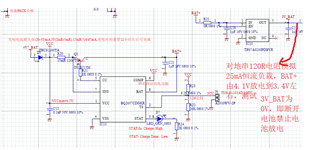Other Parts Discussed in Thread: BQ21040
Hi team,
Using the BQ2057CDGKR, set the 6.67 mA charge current, test the discharge time and find that the battery output is 0V, that is, disconnect the battery to disable the battery discharge, and recharge the battery again. A short to VCC was found due to a short in Q1:

(Please be noted that the Chinese in the figure means: The maximum charge current is 20-50 mA, 2mR-5mR. It takes about twelve hours to fully charge. Test the string 120R resistor to simulate a constant 25-mA load, and BAT+ is discharged from 4.1 V to around 3.4 V. 3 V_BAT is 0 V, which disables battery discharge by disconnecting the battery. )
The customer would like to know is the battery charged and discharged all through Q1?
The 25-mA discharge does not short Q1 because the thermal power consumption of this chip is not exceeded.

Could you help check this case? Thanks.
Best Regards,
Cherry



